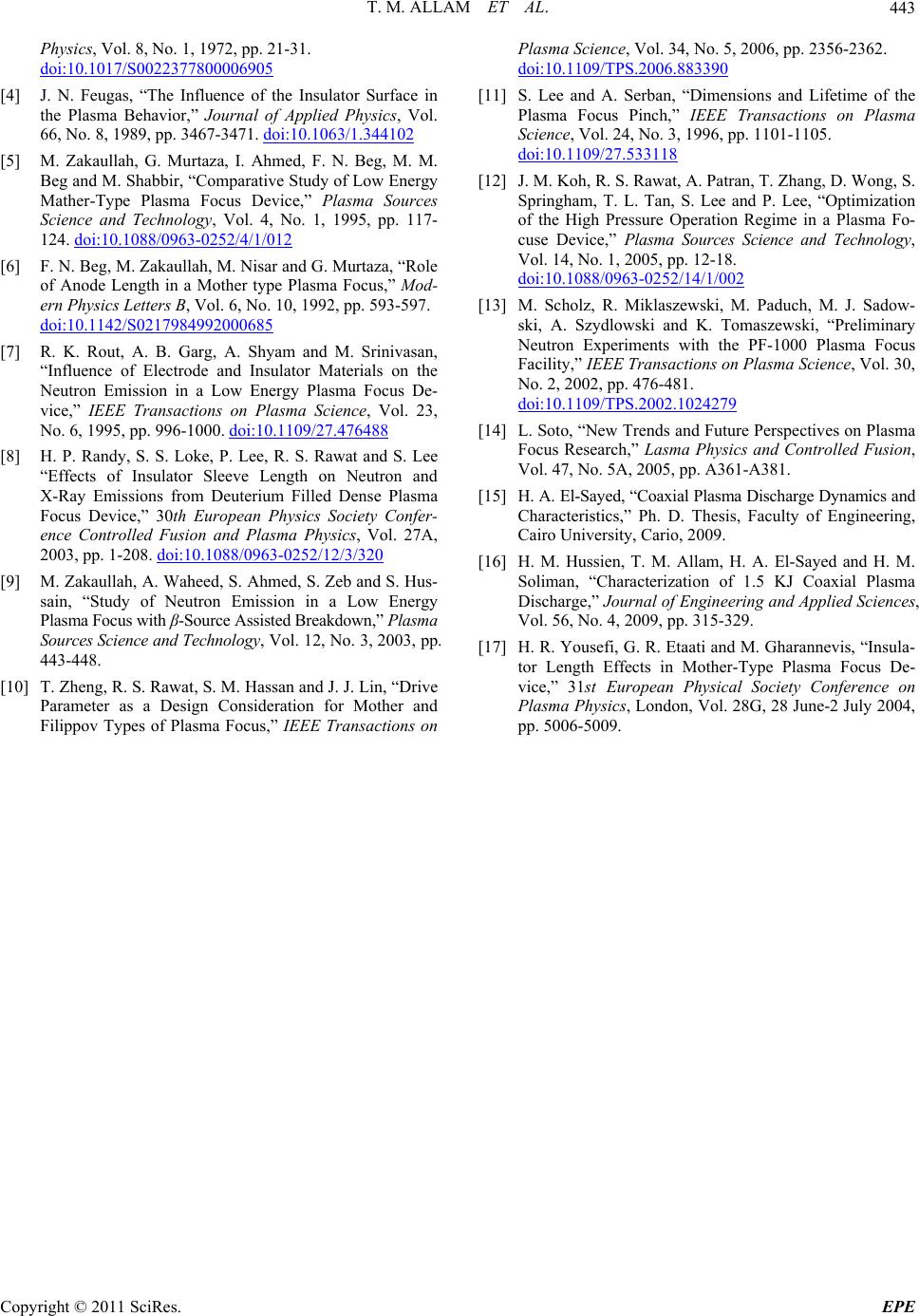
T. M. ALLAM ET AL.443
Physics, Vol. 8, No. 1, 1972, pp. 21-31.
doi:10.1017/S0022377800006905
[4] J. N. Feugas, “The Influence of the Insulator Surface in
the Plasma Behavior,” Journal of Applied Physics, Vol.
66, No. 8, 1989, pp. 3467-3471. doi:10.1063/1.344102
[5] M. Zakaullah, G. Murtaza, I. Ahmed, F. N. Beg, M. M.
Beg and M. Shabbir, “Comparative Study of Low Energy
Mather-Type Plasma Focus Device,” Plasma Sources
Science and Technology, Vol. 4, No. 1, 1995, pp. 117-
124. doi:10.1088/0963-0252/4/1/012
[6] F. N. Beg, M. Zakaullah, M. Nisar and G. Murtaza, “Role
of Anode Length in a Mother type Plasma Focus,” Mod-
ern Physics Letters B, Vol. 6, No. 10, 1992, pp. 593-597.
doi:10.1142/S0217984992000685
[7] R. K. Rout, A. B. Garg, A. Shyam and M. Srinivasan,
“Influence of Electrode and Insulator Materials on the
Neutron Emission in a Low Energy Plasma Focus De-
vice,” IEEE Transactions on Plasma Science, Vol. 23,
No. 6, 1995, pp. 996-1000. doi:10.1109/27.476488
[8] H. P. Randy, S. S. Loke, P. Lee, R. S. Rawat and S. Lee
“Effects of Insulator Sleeve Length on Neutron and
X-Ray Emissions from Deuterium Filled Dense Plasma
Focus Device,” 30th European Physics Society Confer-
ence Controlled Fusion and Plasma Physics, Vol. 27A,
2003, pp. 1-208. doi:10.1088/0963-0252/12/3/320
[9] M. Zakaullah, A. Waheed, S. Ahmed, S. Zeb and S. Hus-
sain, “Study of Neutron Emission in a Low Energy
Plasma Focus with β-Source Assisted Breakdown,” Plasma
Sources Science and Technology, Vol. 12, No. 3, 2003, pp.
443-448.
[10] T. Zheng, R. S. Rawat, S. M. Hassan and J. J. Lin, “Drive
Parameter as a Design Consideration for Mother and
Filippov Types of Plasma Focus,” IEEE Transactions on
Plasma Science, Vol. 34, No. 5, 2006, pp. 2356-2362.
doi:10.1109/TPS.2006.883390
[11] S. Lee and A. Serban, “Dimensions and Lifetime of the
Plasma Focus Pinch,” IEEE Transactions on Plasma
Science, Vol. 24, No. 3, 1996, pp. 1101-1105.
doi:10.1109/27.533118
[12] J. M. Koh, R. S. Rawat, A. Patran, T. Zhang, D. Wong, S.
Springham, T. L. Tan, S. Lee and P. Lee, “Optimization
of the High Pressure Operation Regime in a Plasma Fo-
cuse Device,” Plasma Sources Science and Technology,
Vol. 14, No. 1, 2005, pp. 12-18.
doi:10.1088/0963-0252/14/1/002
[13] M. Scholz, R. Miklaszewski, M. Paduch, M. J. Sadow-
ski, A. Szydlowski and K. Tomaszewski, “Preliminary
Neutron Experiments with the PF-1000 Plasma Focus
Facility,” IEEE Transactions on Plasma Science, Vol. 30,
No. 2, 2002, pp. 476-481.
doi:10.1109/TPS.2002.1024279
[14] L. Soto, “New Trends and Future Perspectives on Plasma
Focus Research,” Lasma Physics and Controlled Fusion,
Vol. 47, No. 5A, 2005, pp. A361-A381.
[15] H. A. El-Sayed, “Coaxial Plasma Discharge Dynamics and
Characteristics,” Ph. D. Thesis, Faculty of Engineering,
Cairo University, Cario, 2009.
[16] H. M. Hussien, T. M. Allam, H. A. El-Sayed and H. M.
Soliman, “Characterization of 1.5 KJ Coaxial Plasma
Discharge,” Journal of Engineering and Applied Sciences,
Vol. 56, No. 4, 2009, pp. 315-329.
[17] H. R. Yousefi, G. R. Etaati and M. Gharannevis, “Insula-
tor Length Effects in Mother-Type Plasma Focus De-
vice,” 31st European Physical Society Conference on
Plasma Physics, London, Vol. 28G, 28 June-2 July 2004,
pp. 5006-5009.
Copyright © 2011 SciRes. EPE